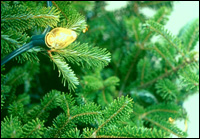Dear Umbra,
Please settle our office dispute. Which is better for the environment: real or fake Christmas trees? Some believe that cutting down juvenile trees, displaying them for two weeks, then throwing them in the garbage is destructive, wasteful, and highly unfriendly to the environment. Others say that the Christmas-tree business keeps land that would otherwise be developed in trees, if only for a short while. Besides, fake trees are made of plastic, which is made from petroleum. (But you can keep using them for many years.)
Trisha
Washington, D.C.
Dearest Trisha,
Ah, yes, that annual question: What does the Gristmas tree look like? I think our office is going to get more of a Christmahanukkwanzaa cheese sculpture type of item.

You might be shocked to learn that I fell in love with artificial trees while researching this question. Fake-tree outlets have truly choice names: House of Trees, Christmas in America, Christmas Depot. The branches can hook or hinge or clip onto the trees, like a giant tinker toy, and you can order any tree you like, in a huge variety of genus and species. Even better, you can get a pre-lit tree or a pre-frosted tree (I think it’s supposed to look like snow, not icing) or a tree with a warranty. Now, that’s a family heirloom to which nature cannot hold a candle. (Petrified trees are so few and far between.)
Imagine my devastation, then, while cruising around in the World Wide Woods, to discover that my newly beloved fake trees are PVC (polyvinyl chloride) in yet another guise. Such a brief, intense love affair. Remember: no on vinyl, and that’s final. We are boycotting vinyl to the greatest extent possible, people. The bright side is that it takes the debate out of the artificial Christmas tree dilemma.
I’ve looked on site after site and called various places, and I can tell you that polyvinyl chloride is the monoculture of the artificial forest. Even worse, lead is apparently used to stabilize certain PVC products, which is why you’ll see a label on faux Christmas trees cautioning you to avoid inhaling or eating any bits of lead dust that may fall from the “branches” of the family heirloom. Now, I’m not saying you need to run screaming from the house, but between the lead and the vinylness, I just can’t support artificial trees.
If you must have a tree, the good old-fashioned wooden kind is the right option. That does not necessarily make them a great option, though, and you should do your tree-selecting with care. Christmas trees are an agricultural product and carry the attendant issues of all mass agriculture. There are trees grown with pesticides and herbicides vs. organic specimens, there are family operations vs. large-scale producers, etc. The bottom line: Go for the actual tree and try to support a small-scale sustainable grower if you can.
Now, some eco-tip-happy folks will suggest additional options. There’s the “Buy a live tree and plant it” option, which I think is excessively poor advice if you a) live in a city or b) are susceptible to charging ahead with plantings inappropriate to your landscape. More reasonably, there’s the “Don’t buy a tree at all!” option, which I trust you have all already considered. If not: Have you thought about having no tree and living vicariously through the trees of others, decorating a living exterior tree, decorating a house plant, or making your own tree as an ambitious crafts project?
Merrily,
Umbra

